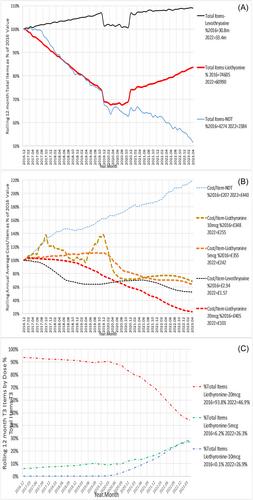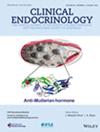Liothyronine (LT3) prescribing in England: Are cost constraints inhibiting guideline implementation?
Abstract
Background
Primary hypothyroidism affects about 3% of the general population in Europe. In most cases people with hypothyroidism are treated with levothyroxine. In the context of the 2023 British Thyroid Association guidance and the 2020 Competitions and Marketing Authority (CMA) ruling, we examined prescribing data for levothyroxine, Natural desiccated thyroid (NDT) and liothyronine by dose, regarding changes over the years 2016–2022.
Design
Monthly primary care prescribing data for each British National Formulary code were analysed for levothyroxine, liothyronine and NDT.
Patients and Measurements
The rolling 12-month total/average of cost or prescribing volume was used to identify the moment of change. Results included number of prescriptions, the actual costs, and the cost/prescription/mcg of drug.
Results
Liothyronine: In 2016 94% of the total 74,500 prescriptions were of the 20 mcg dose. In 2020 the percentage prescribed in the 5 mcg and 10 mcg doses started to increase so that by 2022 each reached nearly 27% of total liothyronine prescribing. The average cost/prescription in 2016 of 20 mcg was £404/prescription and this fell by 80% to £101 in 2022; while the 10 mcg cost of £348/prescription fell by only 35% to £255 and the 5 mcg cost of £355/prescription fell by 38% to £242/prescription. The total prescriptions of liothyronine in 2016 were 74,605, falling by 30% up to 2019 when they started to grow again - most recently at 60,990−15% lower than the 2016 figure, with the result that total costs fell by 70% to £9 m/year.
Conclusions
Liothyronine costs fell after the CMA ruling but remain orders of magnitude higher than for levothyroxine. The remaining 0.2% of patients with liothyronine treated hypothyroidism are still absorbing 16% of medication costs. The lower liothyronine 5cmg and 10 mcg doses as recommended by BTA are 240% the costs of the 20 mcg dose. Thus, following latest BTA guidance which recommends the lower liothyronine doses still incurs substantial additional costs vs the prescribing liothyronine in the no longer recommended treatment regime. High drug price continues to impact clinical decisions, potentially limiting liothyronine therapy availability to a considerable number of patients who could benefit from this treatment.


 求助内容:
求助内容: 应助结果提醒方式:
应助结果提醒方式:


